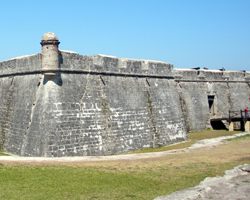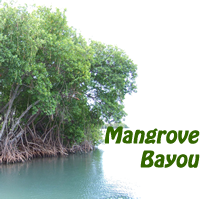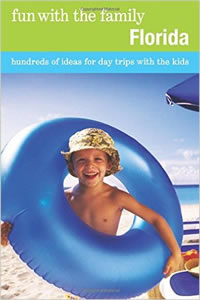Menéndez landed in Florida in early August, 1565. Within two months he had established a Spanish colony, destroyed a French fort near Jacksonville and massacred its garrison, and started construction of the first of many forts which would secure the town and protect offshore fleets.
St. Augustine barely survived, its residents grimly clinging to the edge of a vast unexplored, hostile continent, kept alive by food shipped in from Havana, by gunpowder and reinforcements from Spain, and by the fortress that dominated the town and which was St. Augustine's reason for being.
The present Castillo de San Marcos is, by some estimates, the tenth fort built in the vicinity. The previous nine either burned down accidentally or were eaten by insects or were destroyed by the forces of wind and waves during hurricanes.
Nevertheless, it was not until 1672 that the walls of the present stone fort began to rise. It was another 24 years before the castillo was substantially finished.
The fort is built of soft coquina rock, composed of tiny sea shells. Once exposed to air, the coquina gradually hardened although it is still so soft that the National Park Service warns visitors not to sit on the walls.
The coquina offered an unexpected advantage. An English soldier present at the siege of 1740 noted that the stone, "Will not splinter but will give way to a cannon ball as though you would stick a knife into cheese." The walls are still pockmarked with deep holes.
The earliest houses in St. Augustine were of wood, with palm thatch. They were also tiny, wet, moldy, and short-lived. Tapia, or "tabby," a concrete made from ground lime, sand and shell, was tried next. It disintegrated nearly as fast as the wood. As soon as the stone castillo was finished and the quarry freed for other uses, the residents rebuilt the town entirely of coquina rock.
As forts go, the castillo is tiny. But it was enough to secure Spanish dominion over Florida for 236 years. (Indeed, it will not be until the year 2057 that St. Augustine will have been an American city for as long as it was a Spanish city.) The fort was originally covered with a brilliant white plaster and the towers at the corners were painted scarlet. The red-and-white motif symbolized the Spanish flag and told all who passed by that the fort was still in Spanish hands.
The English did their best to change that, attacking the fort several times. Pirates, too, tried the fort's defenses. At first the townspeople fled to the fort at each attack, watching from the parapets as the invaders burned their homes yet again, the last time in 1702. Eventually the garrison built a moat-and-wall defense around the entire city which kept it secure from further raids.
In 1763, Spain traded Florida to England in a peace treaty. Most of the inhabitants vacated the city, to be replaced by English immigrants. A mixed group of Minorcans, Italians and French stayed on and the town culture became a mixture of Spanish, Mediterranean, and English societies.
After twenty years of English rule, another treaty gave Florida back to Spain. Spanish citizens returned, while many of the English remained. Americans, from the newly-free colonies to the north also began to filter into Florida.
The Americans were a serious nuisance to the Spanish crown, stirring up the indians, causing civil unrest in the more settled areas, and calling for their government to forcibly seize Florida. Spain, bowing to the inevitable, sold Florida to the United States in 1821.
Americans came slowly at first, and wars with the indians and the Civil War hindered progress. St. Augustine sat the war out, firmly occupied by Union troops.
After the Civil War, Florida grew swiftly, especially when the railroads pushed south along the seacoast. St. Augustine became a resort town, and railroad magnate Henry Flagler built several hotels for the winter visitors.
Today those grand hotels have been turned to other uses. The Hotel Ponce de Leon is now the site of Flagler College, a private liberal-arts school. The Cordova Hotel is the St. Johns County Court House, and the sprawling Alcazar houses the Lightner Museum and some city offices.
Before touring the town it is best to stop at the Visitor Information Center for brochures, guidebooks, and discounts for many of the attractions. Then brush up on your history, stopping at the "Dream of Empire" movie, shown nine times daily. The movie takes one hour and covers the city's history in quite accurate detail. Next, visit the Lightner Museum in the Alcazar, and the museum operated by the State of Florida at Government House (ask any shopkeeper for directions).
Now you're ready to start walking, and you will walk a lot. A few warnings: There is very little in the way of wheelchair accessibility in this town. Comfortable shoes and (in summer) a hat are essential. And, while this city is totally dominated by its Spanish heritage, there are very few Spanish-language, or even bi-lingual, directions, information or explanations.
If walking isn't your style, take a train or buggy, or rent a bicycle. Inquire at the Visitor's Information Center for details. The "trains" also package short tours which include admission to some events.
The horse-drawn buggies range from larger versions which carry up to 16 people to intimate carriages perfect for that moonlight drive.
Things to see include the Spanish Quarter, a "living museum" which shows houses of various periods in the city's history. To see more of the lifestyle of 16th-century colonists, you may visit the Spanish Military Hospital, a number of religious shrines, including Nombre de Dios, the site of the first mission (and the site of a current archeological excavation), the "oldest" house, "oldest" school house, and "oldest" store. (The town dates from 1565 but remember that, with the exception of the fort, no standing building predates the English burning of the city in 1702.)
Other attractions include the Ripley's Believe It or Not Museum, the Moorish-style Zorayda Castle, and the Museum of Weapons, with cannon from shipwrecks and Confederate guns. For more modern gunnery, visit the Portman Firearms Museum. Potter's Wax Museum bills itself as the nation's oldest wax museum. For art-lovers, the Florida Portrayed, Museum of Art & History is interesting, with paintings, prints, maps and books spanning more than 400 years of Florida history.
You cannot, of course, leave St. Augustine without seeing what Ponce de Leon came to find when he discovered La Florida. The Fountain of Youth Archeological park is located just north of the fort and the Ripley's Museum. There's even a fountain gushing forth water that might make you youthful&emdash;if you only believe hard enough.
It would take at least two very full days to see only the historic center of the city. But if history begins to bore you, there are nearby alternatives. The Whetstone Chocolate factory has tours, and the St. Augustine Outlet Center offers factory direct savings. Marineland of Florida is just south of the city on the mainland and the St. Augustine Alligator Farm is across the Bridge of Lions on Anacosta Island. There are also deep sea fishing, beautiful beaches, and a number of regularly-scheduled events, ranging from Founders Day (September 4-5) to the Great Chowder Debate (October 31) to the Grand Illumination parade (December 4). For a list of events, call the Chamber of Commerce at 904-829-5681.
The Chamber or the Visitor Center can also provide you with listings of Bed-and-Breakfast lodgings in the historic district. This is the best way to relax after a hard day of pounding the 400-year-old pavement. Ask your landlord for the nearest dinner options, and get very specific directions. You will have to find your way through dimly-lit narrow alleys to tiny, but wonderful, restaurants hidden away in old houses. But, as Don Pedro Menéndez de Avilés might have told you, the destination will be worth the voyage.
end |




